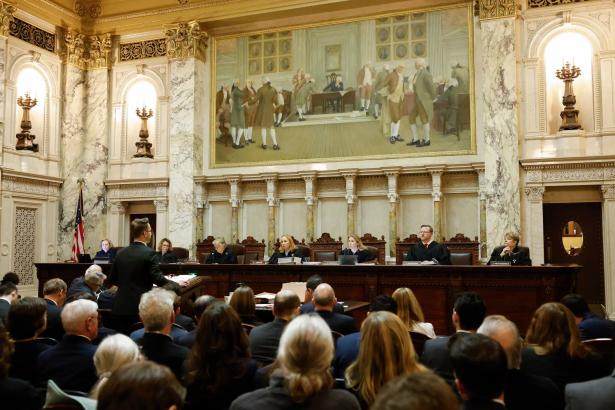The Wisconsin Supreme Court said on Friday that the state’s heavily gerrymandered legislative maps that favor Republicans were unconstitutional and ordered new maps before the 2024 election. The ruling has the potential to produce a seismic political shift in a crucial presidential swing state.
Justice Jill J. Karofsky, writing for the majority, said that Wisconsin’s current maps violate a requirement in the State Constitution “that Wisconsin’s state legislative districts must be composed of physically adjoining territory.”
“Given the language in the Constitution, the question before us is straightforward,” she wrote. “When legislative districts are composed of separate, detached parts, do they consist of ‘contiguous territory’? We conclude that they do not.”
The decision was widely expected from a court that flipped to a 4-to-3 liberal majority this year after the most expensive judicial election in U.S. history. The winner of that election, Justice Janet Protasiewicz, a former Milwaukee County judge, was openly critical of the current legislative maps, calling them “rigged” and “unfair” during her campaign.
The petition, filed on behalf of 19 voters in Wisconsin, sought to have new maps drawn by March. In the 4-to-3 decision on Friday, the court said that if lawmakers do not produce new legislative maps, it is prepared to adopt its own.
Democrats will now have the opportunity to make gains in a legislature that is currently heavily tilted to favor Republicans. In a state with an electorate that is split roughly equally between Democrats and Republicans, Republicans hold a 64-35 majority in the Assembly and a 22-11 supermajority in the Senate. The Democratic governor, Tony Evers, was re-elected to a second term in 2022 and will serve until at least 2026.
“It’s a great day for democracy in Wisconsin,” said Kelda Roys, a Democratic state senator. “This gives us a chance to finally have fair maps and let the voters choose their elected leaders, rather than the other way around.”
But Republicans suggested that the battle over legislative maps was not over. Robin Vos, the Republican speaker of the State Assembly, said in a statement that the case “was pre-decided before it was even brought.”
“Sad day for our state when the State Supreme Court just said last year that the existing lines are constitutional,” he said. “The U.S. Supreme Court will have the last word.”
Earlier this year, Mr. Vos had threatened to move to impeach Justice Protasiewicz because of her statements calling the maps “rigged,” but he has since backed away from those comments. On Thursday, he called impeachment proceedings against the justice “super unlikely.”
Democrats exulted in the court’s decision, hoping that a newly drawn legislative map would dramatically increase the number of competitive seats statewide.
Greta Neubauer, the Democratic minority leader of the Assembly, said that new maps could potentially shift the balance of power in the Legislature.
“If the maps that come out of the court are fair, we absolutely have the opportunity to win a majority in Wisconsin,” she said.
That notion was dismissed by the former Republican governor Scott Walker, who in an email on Friday called the ruling a “partisan decision” and rejected the suggestion that redrawn maps could result in legislative majorities for Democrats.
“This is not the win the left thinks it is,” Mr. Walker said.
Other Republicans criticized the ruling as a power grab by Democrats in the immediate wake of Justice Protasiewicz’s election.
“We certainly expected this,” said Duey Stroebel, a Republican state senator. “She said while running for office that the maps were rigged. Now that they have control of the court, they legislate from the bench.”
In an angry dissent, Justice Annette Ziegler, one of three conservatives on the panel, denounced the liberal majority as “robewearers” who “grab power and fast-track this partisan call to remap Wisconsin.”
“The court of four takes a wrecking ball to the law, making no room, nor having any need, for longstanding practices, procedures, traditions, the law, or even their coequal fellow branches of government,” she wrote. “Their activism damages the judiciary as a whole.”
The Wisconsin Supreme Court heard oral arguments over the fairness of the state’s maps in November, as bystanders packed into a courtroom in the State Capitol.
Conservatives on the court accused Democrats of waiting to raise their claim that the maps violated the State Constitution until they had secured a liberal majority on the court.
“Everybody knows that the reason we’re here is because there was a change in the membership of the court,” said Justice Rebecca Bradley, interrupting a lawyer representing Democratic voters.
Lawyers representing Republicans said that in the past Democrats had not raised claims of unfairness about noncontiguous districts. One of the lawyers, Taylor Meehan, said the Democrats’ claims were “meritless.”
“Wisconsin is the only state that has anything that looks anything like this,” Mr. Gaber said of the current district boundaries, adding, “This shocks people across the country who look at this map.”
It was not immediately clear what effect a redrawn legislative map in Wisconsin might have on the presidential election in 2024. Democrats said they were optimistic that new maps would create competitive elections in more districts, potentially boosting turnout.
Dan Lenz, a lawyer for the petitioners, called the decision “a victory for a representative democracy in the state of Wisconsin.”
“For too long, right-wing interests have rigged the rules without any consequences,” he said. “Gerrymandered maps have distorted the political landscape, stifling the voice of the voters.”
Julie Bosman is the Chicago bureau chief of The New York Times, reporting on the Midwest. She has written for The Times on the coronavirus pandemic, education, politics, law enforcement and literature. She joined The Times in 2002 as a news assistant in the Washington bureau.


Spread the word